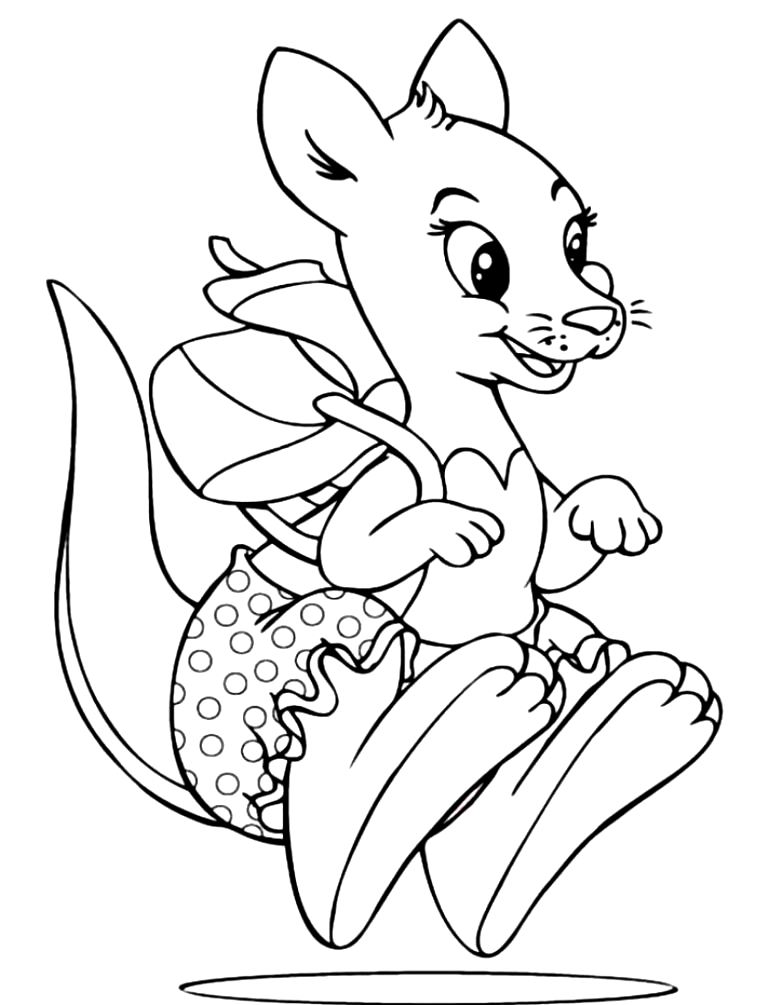Kangaroo
Kangaroo coloring pages look quite interesting. While working with the kangaroo coloring page, children both learn and develop their coloring skills. When painting this animal we will need various coloring pencils. Among them, the most important are; I can count brown, yellow, black, and orange.
Kangaroo coloring pages (free printable)
We hope you enjoyed our kangaroo coloring pages. Now I want to give you interesting information about kangaroos. The homeland of kangaroos, which have inspired many outfits due to their marsupial nature, is the continent of Australia. Kangaroos, which are herbivores, usually feed on plants and nuts. Their biggest feature is that their offspring are born very small and complete their development in their mothers' pouches.
Kangaroo and its Features
The kangaroo family consists of 11 genera and 62 species. The maximum length is 3 meters in the eastern gray kangaroo. Second, a giant red kangaroo is 1.65 meters tall. However, the red giant kangaroo is not a very heavy animal. Its weight is around 45 kilograms on average. While the eastern kangaroo weighs 95 kg, its maximum weight is 85 kg. Generally, male kangaroos are larger than females. The growth of males continues until they are older, while the growth of females is suspended for a short time after reproduction begins. The female gray or yellow kangaroo weighing 15-20 kg, which is the first to participate in breeding, is 5-6 times more than her. In contrast, small kangaroos of different sexes have similar sizes to adults. Large kangaroos are very interesting animals, they are difficult to recognize. They have a small head, large ears, and large almond-shaped eyes. The eyes are framed by long dense eyelashes that protect the cornea from dust. The kangaroo's lower jaw has a unique structure, its posterior ends bent inwards. In total, 34 teeth are adapted for feeding on thick plant foods. The kangaroo neck is slender, the thorax narrow, the front paws appear underdeveloped, while the jumping legs are very strong and massive.
The tail, which is thick at the base and tapering towards the tip, acts as a stabilizer when jumping, and in large individuals it becomes the support of the body during fights and sitting. It does not perform a satisfactory function. The length of the kangaroo tail ranges from 14.2 to 107 cm, depending on the species. In other species of kangaroos, the tail is shorter and thicker and also less hairy. Muscular thighs support the narrow pelvis of mammals. In the longer bones, the lower leg muscles are less developed and the ankles are arranged in such a way that they prevent the foot from turning sideways. During rest or slow movement, the weight of the animal's body is distributed over the long, narrow legs, creating a stop loss effect. However, during a jump, the kangaroo only stands on two legs. In some cases, the first toe of the foot is completely lost. These mammals can not only jump, but also walk slowly on all four limbs, in this case the feet move in pairs, and not alternately. When large and medium-sized animals raise their hind legs forward, they rest on the tail and front paws. While jumping, kangaroos can reach speeds of 40-60 km/h, but this figure is for short distances. Because their journey is so intense, when a fast jump starts, they get tired after 10 minutes and slow down. When resting, they sit on their hind legs, keeping the body upright and leaning against the tail or lying on their side.
Kangaroo Species
Kangaroo species include Red Kangaroo, Eastern Gray Kangaroo, Western Gray Kangaroo and Antelope Kangaroo.
Where Do Kangaroos Live?
Kangaroos can live in different habitats from each other. There are those that live in bushes, those that live in mountainous areas, and those that live in trees. Most kangaroo species live and belong to the Australian continents. Large kangaroos live mainly in Australia and tree kangaroos in New Guinea.
What Are the Characteristics of Kangaroos?
kangaroos; It belongs to the chordate branch, mammalian class, two anterior denticles.
- They are animals belonging to the kangaroo family. They are the most well-known marsupials.
- They are animals that are generally active at night.
- Kangaroos, whose speed can reach 50 km/h, can jump about 3 meters in one jump.
- Tree kangaroos can't jump well, but they are very good climbers.
- Kangaroos are ruminant animals.
- Female kangaroos have highly developed pouches and the female only gives birth to a single calf.
- Pregnancy is short in kangaroos, as in most marsupials. This period is about 20-40 days. Cubs are born immature.
- When the cubs are born, they are 2 cm in size and weigh 1 g.
- After the kangaroo cubs are born, they climb into the pouch on their own and hang from a udder. He does not take this breast out of his mouth for 2-3 months. They come out of the pouch for the first time after 6 months and do not fit in the pouch when they are 8 months old.
- Baby kangaroos are fed milk until they are 1 year old.
- They feed on grasses and plants.
- They are domesticated animals.
- Their average lifespan is 15 years.
- Kangaroos can reach up to 210 centimeters in length, and their weight can reach 90-100 kilograms.
- They prefer to graze by walking in herds.
- Their hides are usually earthy colour.
Generally calm and rarely angry, kangaroos can kick very hard if cornered. It is such that these kicks can kill a person or a predatory dog in one move.








